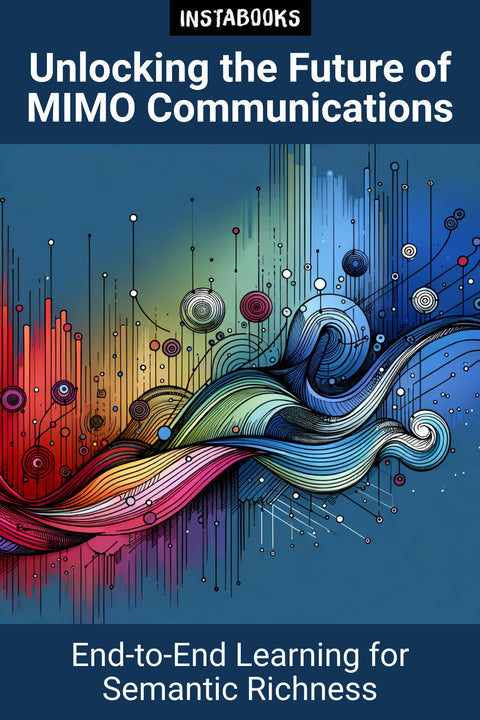
Unlocking the Future of MIMO Communications
End-to-End Learning for Semantic Richness
Included:
✓ 200+ Page AI-Generated Book
✓ ePub eBook File — read on Kindle & Apple Books
✓ PDF Print File (Easy Printing)
✓ Word DOCX File (Easy Editing)
✓ Hi-Res Print-Ready Book Cover (No Logo Watermark)
✓ Full Commercial Use Rights — keep 100% of royalties
✓ Publish under your own Author Name
✓ Sell on Amazon KDP, IngramSpark, Lulu, Blurb & Gumroad to millions of readers worldwide
Introducting a New Era in Wireless Communication
\nImmerse yourself in the burgeoning field of end-to-end learning for task-oriented semantic communications over MIMO channels. This book unveils a groundbreaking approach that transcends traditional methods by incorporating semantic awareness into modern communication systems. Discover how integrating machine learning techniques such as autoencoders can optimize communication tasks, significantly minimizing semantic errors while maximizing the value of transmitted information.
\nExploring Key Concepts and Frameworks
\nDelve into the intricacies of task-oriented semantic communications, where the focus is on decoding the meaning behind transmitted symbols and bits. The text guides you through the end-to-end learning framework, highlighting its ability to ensure system optimization by jointly training feature encoders, MIMO precoders, and classifiers.
\nThe concept of decoupled pretraining is meticulously explored, shedding light on how separate pretraining of feature encoders and MIMO precoders can align pretraining objectives with end goals efficiently. This leads to enhanced performance with minimal training load.
\nHarnessing Rate-Distortion Theory and Real-Time Feedback
\nGain insights into the application of rate-distortion theory, an essential aspect in comprehending the balance between rate and distortion during information transmission. Learn how CSI feedback is vital for prioritizing critical semantic data, ensuring effective utilization of communication channels.
\nImplementing Information-Theoretic Principles
\nUnderstand how conditional mutual information maximization forms the core of the framework by aligning feature encoding, MIMO precoding, and classification objectives. Analyze groundbreaking simulation results that demonstrate significant improvements in classification accuracies over standard methods.
\nEnvisioning Practical Applications
\nThis comprehensive guide unveils practical applications, including AR-enhancing communication frameworks like TSAR, optimized for transmitting rich semantic data. Explore how next-generation communications can enhance diverse applications, from virtual reality experiences to autonomous driving, through machine learning-integrated task-oriented communications.
Table of Contents
1. Introduction to Semantic Communications- Understanding Task-Oriented Approaches
- Evolution of Communication Systems
- Role of Semantics in Communications
2. End-to-End Learning Framework
- Joint Training Techniques
- Feature Encoder Design
- MIMO Precoding Principles
3. Decoupling and Pretraining
- Pretraining Strategies for Efficiency
- Aligning Objectives
- Practical Implementations in MIMO
4. Autoencoder Optimization
- Minimizing Semantic Error
- Maximizing Information Value
- Techniques and Algorithms
5. Rate-Distortion Theory Applications
- Balancing Rate and Distortion
- Designing for Quality
- Theory in Action
6. Role of CSI Feedback
- Channel State Information
- Enhancing Communication Reliability
- Utilizing Feedback for Optimization
7. Information-Theoretic Frameworks
- Conditional Mutual Information
- System-Level Optimization
- Insights from Simulation Results
8. Augmented Reality Enhancements
- Transmission of Semantic Data
- TSAR Framework Benefits
- Augmenting the AR Experience
9. Next-Generation Communication Systems
- Integration of Machine Learning
- Optimizing for Diverse Applications
- Meeting QoE Needs
10. Simulation and Results
- Testing with CIFAR-10
- Results from ModelNet10
- Comparing Baselines
11. Implementing Advanced Systems
- Design Challenges
- Overcoming Limitations
- Future Prospects
12. Concluding Reflections
- Lessons Learned
- Impact on Future Technologies
- Final Thoughts and Directions
Target Audience
This book is aimed at researchers, engineers, and students interested in wireless communication, machine learning, and information theory.
Key Takeaways
- \n
- Understanding task-oriented semantic communications for enhanced task performance. \n
- Exploring end-to-end learning frameworks with joint training for optimization. \n
- Applying autoencoder techniques to minimize errors and optimize information value. \n
- Leveraging rate-distortion theory for efficient communication design. \n
- Utilizing CSI feedback for reliable and efficient wireless communication. \n
- Integrating information-theoretic principles for system-wide improvements. \n
- Implementing practical applications in AR and next-gen communication systems. \n
